skip to main |
skip to sidebar
My visit to the Open Day of the Global Centre for Rail Excellence in June 2023 (described here) led to curiosity about the story of one of the minor standard-gauge railways of South Wales, the Neath and Brecon.
A very brief history
The geology of Wales gave the country massive deposits of coal and other minerals. The Dulais Valley north of Neath had a number of mines which, in turn, prompted the establishment of a number of iron and copper works in the area. Initially, tramroads were used to assist mineral extraction but the growth of steam power (in manufacturing, railways and steamships) increased demand for coal and this led to the building of a number of railways in Wales with virtually each valley producing its own railway. The Dulais Valley spawned the standard gauge Neath and Brecon Railway (N&B). At Neath, the railway ended in a junction with the broad gauge Vale of Neath Railway (VoN) from where a third rail was added for a short distance so that N&B trains could terminate at the VoN station initially called Neath Low Level. This station also formed an end-on connection with the broad gauge Swansea and Neath Railway which in 1863 merged with the Vale of Neath. The first ten miles of the N&B route, from Neath to Onllwyn, was a reasonable proposition because of the established mining industry. But continuing to Brecon, via an arduous route through largely barren uplands made matters problematic. The line opened in 1864 from Neath to a colliery at Onllwyn and in 1867 was extended initially to Brecon Mount Street station, then, in 1874, to an end-on connection at Free Street joint station with the Brecon and Merthyr Junction Railway which also served the Mid Wales Railway (giving connections to the Cambrian Railway) and, via the junction at Three Cocks, the Hereford, Hay and Brecon Railway. There are links to articles on these other railways in the 'Related articles on other websites' below.
The early days of the Neath and Brecon were not unusual amongst many railways of the period in being associated with various enthusiastic amateurs and dishonest men, resulting in bankruptcy narrowly averted. Improbably, an agreement with the Midland Railway was to provide a lifeline. The Midland was seeking a route from the Midlands to Swansea and this was achieved by a complex web of agreements. The Swansea Vale Railway (SVR), a standard gauge line, was seeking investment and their terminus at Swansea St. Thomas with access to the docks appealed to the Midland. The SVR line passed through Ynysgeinon and the construction of a new Neath and Brecon Junction line from here for seven miles on a rising gradient of 1 in 50 and 1 in 55 to join the N&B at Colbren Junction gave the Midland Railway a route from Swansea to Hereford and beyond. The Junction line opened in 1867 (and was finally closed to all traffic in 1967). Through traffic from the Midland Railway secured the railway's future but local passenger traffic remained poor. The demand for coal and anthracite allowed the Neath and Brecon to continue as an independent company until absorbed into the GWR in 1922 by the Grouping. In the 1920s Neath Low Level was first renamed Neath Bridge Street and finally, a couple of years later, Neath Riverside.

Click for larger view
Neath and Brecon Railway Map in 1871. The N&B Junction line is shown dotted (National Archives)
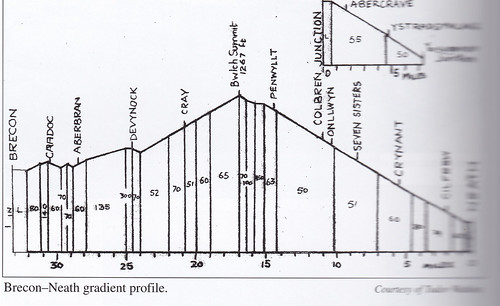
Click for larger view
Neath and Brecon Railway Gradient Diagram (Tudor Watkins Collection)

Click for larger view
Map of Swansea Vale Railway, 1875, showing how the Swansea Vale Railway (in red) paralleled the Neath and Brecon Railway (shown in green) and part of the N&B Junction line which joined the two routes. (By Afterbrunel - Own work, CC BY-SA 4.0)
The Railway after Nationalisation
The railway was the haunt of the various classes of 'Pannier' tank. Although demand for coal remained strong, by 1954 there were only two passenger round trips daily from Neath to Brecon, worked by one locomotive based at Neath. In 1958 this had reduced to one round trip on weekdays. By 1961, passenger services beyond Colbren Junction ceased with three round trips daily between Neath and Colbren Junction. The line between Craig-y-Nos and Brecon was closed to all traffic in 1962 and the remaining passenger services were withdrawn in 1964. From 1970, the quarry at Craig-y-Nos started to supply limestone to Llanwern steelworks.

Click for larger view
A Brecon train prepares for departure from Neath Riverside on 14 July 1962, a few months before closure. The South Wales main line crosses on the overbridge in the distance (Photo: Flying Stag, CC BY-SA 3.0, via Wikimedia Commons)
Change to Opencast Mining
Over time, underground mining in the area gave way to opencast mining. Excavators first remove topsoil which is stored in soil mounds to be reused in remediation work when mining is complete. Excavators then remove the unwanted material ('overburden') to access the coal-bearing layers beneath, resulting in a large pit or void. A network of roads allows the coal extracted by excavators to be hauled away. Remediation of areas once extraction ceases can start in some areas even as opencast mining continues in others. Opencast coal is frequestly "washed" to meet the customer's requirements by removing impurities. In a typical industrial Coal Washing process, water is added so that different particles in the coal sink to various depths depending on their densities, allowing separation. The Nant Helen Opencast Mine, near Onllwyn was authorised in 1985 and Onllwyn Wahery was built to process the product which was then transported by rail. The UK commitment to 'de-carbonise' the economy meant that fossil fuel burning needs to be eliminated and friction has arisen with the mining companies. More information can be found on the Coal Action Network site and a report specific to Nant Helen is here. A similar report on the nearby East Pit is here. The refusal by the Coal Authority (a non-departmental public body sponsored by the Department for Energy Security and Net Zero) to issue a license for continued extraction at Nant Helen precipitated closure of the mine and Washery and the railway was mothballed.
Recent history of the line to Onllwyn
Until 2022, coal from Nant Helen was loaded onto rail wagons at Onllwyn Washery and carried away using the former Neath and Brecon Railway via the remaining connections to the South Wales Main Line in the Neath area. In the future, it is intended that the branch to Onllwyn be used to provide a railway connection to the proposed Global Centre for Rail Excellence. Before closure at Onllwyn Washery, for a time coal was also brought from Gwaun-Cae-Gurwen (situated on the branch diverging from the Central Wales Line at Pantyfynnon which had served East Pit) to Onllwyn, as shown in the picture below.

Class 60 No. 60054 arrives at Onllwyn Washery on 26-Oct-2018 with the second train of the day of loaded coal wagons from Swansea Burrows sidings (the wagons having arrived the previous day from Gwaun-Cae-Gurwen opencast site). Once unloaded all the empty wagons will return to Swansea Burrows as one, long train (Photo: Gareth Jones)
Signalling
The Neath and Brecon was signalled following Great Western practice. All the signal boxes are abolished but the much-altered and modernised signal box at Neath Riverside was retained to control the remains of the Neath and Brecon (the 'long siding' to Onllwyn) and the remains of the Vale of Neath (the 'long siding' to Cwmgwrach). There's a very informative illustrated report by the Branch Line Society here describing their visit to Port Talbot Power Signal Box and the Neath Riverside Box.
Book references
[1] 'Track Layout Diagrams of the Great Western Railway: Section 52 Neath and Brecon 2nd edition'' by R A Cooke, published Lightmoor Press (ISBN 9781871674507).
[2] 'The Neath and Brecon Railway: A History' by Gwyn Briwnant Jones, Denis Dunstone & Tudor Watkins, published Gomer (ISBN 1-84323-452-1).
[3] ‘A Regional History of the Railways of Great Britain: Volume 12 South Wales' by D. S. M. Barrie, published by David & Charles (ISBN 0-7153-7970-4).
Related articles on other websites
Neath and Brecon Railway (Wikipedia)
Neath and Brecon Railway (and related lines) (Welsh Railways Research Circle)
Vale of Neath Railway (Wikipedia)
Swansea and Neath Railway (Railscot)
Brecon and Merthyr Tydfil Junction Railway (Wikipedia)
Mid-Wales Railway (Wikipedia)
(Wikipedia)
Hereford, Hay and Brecon Railway (Wikipedia)
Onlwyn No.1 Colliery (Railscot)
Branch Line Society Signal Box visit 12/12/2019 (Branch Line Society)
History of Onllwyn Collieries (Welsh Coal Mines)
Report on Nant Helen (Coal Action)
Report on East Pit (Coal Action)
Usual disclaimer: the above links worked when this post was published but may cease to work in the future if the site owner makes changes.
Related posts on this website
Global Centre for Rail Excellence Open Day
My pictures
GCRE: The Neath and Brecon Railway.
In 2023, my rail trips have been reduced due to my poor mobility, but I thought I'd mention a recent flurry of activity.
25-Nov-2023: Wolverhampton-Birmingham International (return)
The 'Lion' supporters group 'The Old Locomotive Committee' (OLCO) took a stand at the Warley National Model Railway Exhibition on 25th and 26th November held at the National Exhibition Centre (NEC). There are a few random pictures of the event here which may trigger a post at some point. To reach the Exhibition on Saturday 25th November, I travelled with John H. and Geoff H. from Wolverhampton to Birmingham International to man the OLCO Stand. The outward journey was by TfW Diesel Multiple Unit (DMU), rather noisy and crowded but at least fairly fast. The connection from International station to to the NEC by a long, covered footbridge is quite convenient, particularly compared with access by road which I'd undertaken on the previous day (when we'd been setting up) and the following day (when we'd stripped down after the event). Road transport scores when you're transporting all the materials for a small stand (including a 7.25 inch gauge live-steam model!). On Saturday evening, the tired trio walked back to international and caught an Avanti 'Pendolino' service back to Wolverhampton.
28-Nov-2023: Wolverhampton-London Euston
On Tuesday 28th November, I had a Trustee meeting in London so I had booked on-line to travel on the 09:45 Avanti service from Wolverhamton to London (Euston). Sadly, on arrival at Wolverhampton station, I learnt that the train was cancelled at short notice. As far as I could gather from a barely-audible platform announcement this was due to 'equipment failure' and travel to Birmingham by the next available service was recommended. This was the inevitable TfW DMU, noisy and fairly crowded. Birmingham New Street seemed to be fairly disorganised that morning and, failing to find any clear guidance, I reluctantly boarded a West Midland Trains Electric Multiple Unit (EMU) bound for Euston but via the Northampton Loop and stopping everywhere. When the lady train manager came round on ticket inspection, she suggested changing at Coventry as she'd already confirmed that the following Avanti service from Birmingham was running. For some reason, I'd failed to find mention of this at New Street, although I'd expected to find it. This meant about 45 minutes waiting on a rather cold Coventry station but, eventually, I was able to board First Class on a warmer Avanti 'Pendolino'. Of course, I was too late to take breakfast which, in any case, is a very diminished experience compared with a few years ago but with tea and a nicely-presented cheese platter, the day rapidly improved.

A nicely-presented cheese platter, Coventry-Euston by Avanti
Being used to the unreliability of British trains, I'd fortunately allowed a margin in my timings so my later arrival at London still allowed me time to walk the one mile to Victoria House in Bloomsbury Square where the Trustee meeting took place and arrive on time. Following the meeting, I retraced my walking route to Euston.
28-Nov-2023: London Euston-Bangor (Gwynedd)
I had some time to wait before my next booking - the 19:02 Avanti service to Holyhead, alighting at Bangor. I was able to wait in the Avanti First Class Lounge on the Mezzanine Floor, with views of the busy Concourse. It was the first time I'd seen the new Passenger Information System, white-glowing electronic screens arrayed in two banks in the centre of the concourse, at right engles to the north west wall which gives access to the 16 platforms. Previously, that north-west wall hosted a long array of yellow-glowing electronic screens (the black area on the right in the picture below).
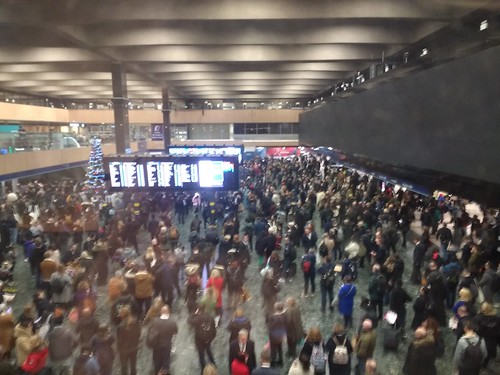
Euston Station Concourse following introduction of new Passenger Information system, viewed from Avanti First Class Lounge on 28-Nov-2023. Note Christmas tree
Modest refreshments were available in the lounge and the staff were helpful so I was content to wait to be joined by Steve M. Late arrival of the incoming train to form our departure and the need for staff to perform some cleaning/servicing before passenger loading meant that no early announcement of departure platform had been made. With a clue from the lounge receptionist and the Railcam.UK 'app' on my mobile phone (there's a brief explanation of Railcam.UK here), I'd worked out the platform number and our train's reporting number (1D93). Steve and I were already en route when the announcement of platform was finally made, only a few minutes before scheduled departure. Steve and I became swept up in the all-too-common rush to join the train. As expected, the train was formed of two Diesel Multiple Unit (DMU) 5-car 'Voyagers' where one end carriage of each unit provides First Accommodation and a Kitchenette. We found our reserved seats fairly readily. I was sure departure would be late but, in fact, we were not more than one or two minutes adrift setting off up Camden Bank on a cold, dark evening. I remembered that, in 2008, I wrote a brief review of King's Cross, St. Pancras and Euston stations (here which was rather scathing about Euston. Over the following years many changes have occurred at Euston but I'm afraid a more up-to-date review would be no kinder.
Modest refreshments were provided during our journey. I was very tired so I was inattentive on the journey. We lost six or seven minutes to Tring but I couldn't work out why - we didn't seem to be following a slower train, as often happens. The lady Train Manager made an apology over the public address but without a full explanation. But, as we approached Milton Keynes, Railcam.UK revealed that we were now closing up to an earlier Euston-Manchester train We were about thirteen minutes 'down' passing Milton Keynes without a scheduled stop and I expected slow progress onwards to Rugby but the Manchester train scooted ahead and showed us a clean pair of heels (or, more accurately, a series of green signals). We didn't stop at Rugby either and picked up some lost time along the Trent Valley line. The train then made a series of scheduled stops at Tamworth, Lichfield and Stafford, arriving at Crewe's platform 12 only about five minutes late. Our diesel-powered train had just come 158 miles 'under the wires' of the 25kV a.c. electrification system. Whereas in some parts of the world even minor lines received some form of electrification following World War II, the particularly blinkered politics of the U.K. have resulted in vast deserts of non-electrified lines, including the whole of the North Wales route. I don't find the appearance of Overhead Line Equipment (OLE) attractive but the extensive use of diesel power when we are supposedly committed to reducing carbon dioxide emissions seems, at the very least, odd. The 'wheeze' of going 'bi-mode', providing trains which are both overhead electric and diesel power as in Class 800 does not appeal either, saddling designs with extra weight, complexity and costs.
Soon, we were off on the Chester line (non-electrified, except in the vicinity of Crewe) for the short 'hop' to Chester. The North Wales line is a fairly 'easy' route, as shown by the gradient diagram below.

Click for larger view
Historical Gradient Diagram: Crewe-Holyhead
With stops at Flint, Prestatyn, Rhyl, Colwyn Bay and Llandudno Junction, the train picked up and then lost occasional minutes along the way but was very close to right time when Steve and I left the train at Bangor after our 239 mile journey from London in reasonable comfort at an average speed of around seventy miles an hour.
Background to the TfW 'Premier Service'
At the end of 2008, Arriva Trains (Wales) introduced a locomotive-hauled 'Premier Service' from Cardiff to Holyhead funded by the Welsh Government. Originally, this operated via Crewe with a pair of Class 57 locomotives top-and-tailing four Mark 2 coaches. Later, a single 57 was used, replaced in 2012 by DB Schenker Class 67s when the coaches were upgraded to Mark 3.

Arriva Trains (Wales) Class 67 002 in between platforms 11 and 12 at the North end of Crewe on 11-Apr-2012
The addition of a Driving Van Trailer (DVT) to the formation later in 2012 allowed push-pull operation and the routing was changed to use the former Great Western route between Shrewsbury and Chester, introducing a reversal at Chester. The Covid pandemic caused suspension of the service between March 2020 and June 2021 when the service was re-introduced using Mark 4 coaches and DVT. A similar service between Cardiff and Manchester, operating via Crewe was also inaugurated.
I'd not managed to plan a journey on the Premier Service but, as explained in the post here, on 27-Jan-2022 I unexpectedly found myself a passenger from Rhyl to Shrewsbury on one of the trains.
30-Nov-2023: Bangor (Gwynedd) - Wolverhampton
Both Steve and I were keen to sample the TfW 'Premier Service' so, when our business was concluded on 30th November, a taxi took us the Bangor station to see what was possible.
It's many years since I passed through the main entrance to Bangor station on the North side of the line and I was delighted to see that the original features in the booking hall are largely intact, including two large, round L.M.S. monograms on the walls. Travel, however, remained rather problematic. Although the Holyhead-Cardiff service is nominally three 'Premier Service' trains a day each way, this does not always happen. The suggestion the lady booking clerk made was to travel First Class on the Avanti Holyhead-Euston service departing at 13:15 as far as Crewe where we could join a TfW 'Premier Service' from Manchester to Cardiff, in my case just for the short 'leg' to Shrewsbury, in Steve's case to Newport.
Tickets were booked and we made our way to the Up platform (now No.1). This involved leaving the booking office on the railway side at ground level, crossing the access road to station car parking via a zebra crossing markings and ascending a ramp to the platform itself. This really 'spooked' me because I'd known and been impressed by Bangor station from childhood. Then, the station had two island plaforms giving four main platform faces. Two through lines were provided for non-stop trains with loops serving the inner faces of the island platforms whilst additional tracks served the outer faces of the island platforms. Originally, the booking hall led to a footbridge across the additional track on the up side leading to steps down to the Up island platform or to a further footbridge across the through and platform loop lines with steps descending to the Down island platform. What confronted me was a mere ghost of what I remember. I get this sense of loss in many places on our emasculated railway system, I'm afraid.

Bangor station, showing Up platform. Cars now park in the area where an additional track formerly served the outer face of the Up island platform
I think the booking hall and footbridges date from the 1927 expansion of facilities (hence the 'LMS' monograms). I'd assumed the remaining station building on the Up platform was earlier but I'd not realised that, although modified over the years, it is the original 1848 Chester and Holyhead railway building designed by architect Francis Thompson of Derby in Italianate style with a hipped, slate roof. I'm pleased to report that the building is now listed Grade II: there are more details here. It was completed to serve the opening of the railway from Chester to Bangor in 1848. Two years later, with the opening of the Britannia Tubular Bridge, Bangor became a through station and facilities were expanded in 1852. I'm afraid I'd not spotted the various Chester and Holyhead monograms set in the outside walls of the building (although four are just visible in my 2014 picture below, snatched from a Down train).

Bangor station buildings on Up platform.
Steve introduced me to the Refreshment Room on the Up platform, with its magnificent wooden counter and fittings. Sadly, the various modernisations render the overall effect rather nondescript.

Bangor Station: Counter and fittings in Refreshment Room on Up platform

Bangor Station: View looking west from Up platform (No. 1) with signal box in background
My view looking east from the Up platform does gives a poor view of the imposing West Portal of Bangor Tunnel. The Resident Engineer for this section of the line, Mr. Forster, adopted an Egyptian style portal using coursed stone forming a square headed opening with tapered sides, a wide swept entablature and cornice. Happily this,too, is listed and you can find brief details here.

Bangor Station viewed from Up Platform (No. 1) looking east showing West Portal of Bangor Tunnel
Our train arrived, a 5-car 'Voyager', and we found accommodation in the leading First Class coach. Modest refreshments were provided during the journey. I tried the cheese and onion 'toastie' which I found excellent. Once east of Abergele, I was able to track our progress on Railcam.UK (our reporting number was 1A50). We made the usual stops and approached platform 3 at Chester very cautiously, which did not surprise me, but the final stop was very firm with a metallic 'clang' which suggested that we'd coupled to another set standing on front of us, using the Dellner autocouplers. This seemed to be confirmed as, on Railcam.UK, our reporting number flickered on and off for a few seconds, presumably as the driving cab next to us was closed and the driving cab now at the head of the train was opened. A brief 'sprint' took us to Crewe, where we arrived at platform 6.
The platform was very busy with people getting off, getting on and trying to work out their next train but I was able to confirm that we'd acquired another 'Voyager' trainset in front of us at Chester. We determined from the passenger displays that the Manchester - Cardiff 'Premier Service' was expected at platform 5, departing at 15:10, so we headed for the lift and made our way to the indicated platform. Before long, the headlights of a class 67 appeared, heading a short train of Mark 4 coaches looking quite smart in black livery. Railcam.UK gave the reporting number as 1V46 and arrival at Shrewsbury at 15:44. The last vehicle was the Driving Van Trailer (DVT) with the First Class/Kitchen car last but one. We were welcomed on board by a young, enthusiastic Chief Steward and settled into the comfortable seats as our train set off from Crewe on the Shrewsbury line. I didn't see much of the unfamiliar route as it was already dusk but mainly because, as I enjoyed a cup of hot chocolate, I chatted to the Chief Steward about the 'Premier Service' of which he was clearly proud. He agreed that the original Holyhead-Cardiff service had been affected by poor availability of trainsets but said that the Manchester-Cardiff service was establishing a strong following. TfW have eight trainsets to cover both routes with two trainsets out of service awaiting repairs on that date, he said.
All too soon, we arrived at Shrewsbury, ending my sampling of the 'Premier Service'. I said goodbye to Steve, who was continuing to Newport, and the Chief Steward, descending onto a cold, dark, windswept platform. I took a few pictures of the train as it left and then faced a wait until 16:34 when a West Midland Trains service from Crewe to Birmingham International (reporting number 1I22) would complete my journey back to Wolverhampton after an interesting, if exhausting, odyssey.

Shrewbury: 'Premier Service' 1V46 in platform 7 on 30-Nov-2023

TfW 'Premier Service' from Manchester to Cardiff at Shrewsbury: 1V46 in platform 7 on 30-Nov-2023
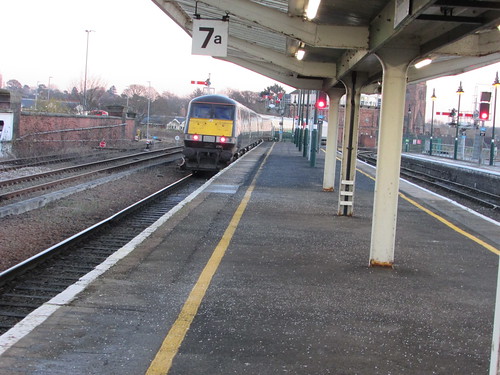
TfW 'Premier Service' from Manchester to Cardiff leaving Shrewsbury showing DVT at rear
Related posts on other websites
TfW Premier Service (Wikipedia)
Bangor Station Building (British Listed Buildings)
Bangor Tunnel Portal (British Listed Buildings)
Usual disclaimer: the above links worked when this post was published but may cease to work in the future if the site owner makes changes.
Related posts on this website
Rail Travel in January 2022
Historical Gradient Diagram, North Wales Line
BR Gradient Diagrams published by Ian Allen
My pictures
Whilst I added very few pictures on the journeys described above, there are a number of earlier pictures in albums covering areas passed through which are linked below:-
Crewe Area Rail
London & Birmingham Railway
London: Euston Station
North Wales Line (Llandudno-Holyhead)
North Wales Line (Crewe-Llandudno)
Nuneaton Station
Rugby Station
Shrewsbury Area Railways
Stafford area rail
Wellington, ex-Great Western Railway
West Midland Railways
Wolverhampton to Shrewsbury Line
In 2023, the Battlefield Line held a Models Weekend on Saturday 19th August and Sunday 20th August. I attended on the Sunday with Dean and we were most impressed.
The venue was Market Bosworth station and, on arrival, we found the car park had 'spawned' a dedicated Bus Stop because a free bus service was being provided in connection with the event between Nuneaton Bus Station and Market Bosworth Station, calling at Nuneaton Railway Station.

Dedicated Bus Stop: Battlefield Line, Models Weekend 2023
The service was being operated by a preserved bus in the azure blue and ivory livery of Midland Scottish, successors to W. Alexander and Son. The vehicle also carried the Bluebird Logo which originated in Alexander's coaching operations.

Near the bus stop, a group of live-steam model traction engines was on parade.
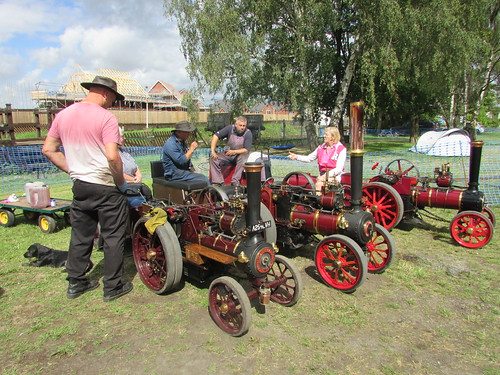
A handsome group of live-steam model traction engines: Battlefield Line, Models Weekend 2023
For a very modest charge there was an opportunity to ride behind live a steam live steam locomotive on the adjacent 5 inch gauge portable track.

Stephen Wallbank with his vertical-boilered live steam model on the portable track: Battlefield Line, Models Weekend 2023
The Goods Shed at Market Bosworth had been significantly expanded by erecting a large marquee end-on to the goods shed. Just inside this annexe was the admission desk and the Battlefield Line information and recruitment desk.
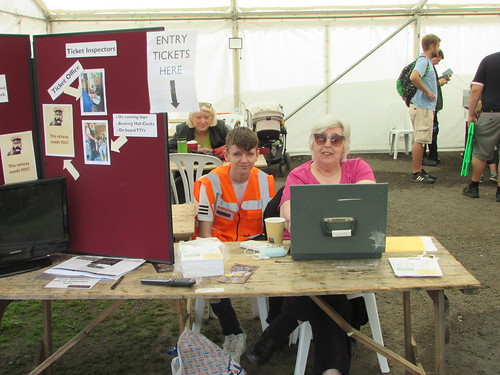

The marquee had an interesting mixture of trade stands (including John Sutton Models, Ravenstone Model Railways and Thunderbolt Models), special stands (including the 4-SUB Association and Railriders) and model railway layouts. Some stands also offered a variety of railway books. The far end of the marquee opened into the brick-built goods shed, through the large doorway which originally accommodated a rail siding. The goods shed housed more stands with an absorbing selection of working model railway layouts in various gauges together with the cafe run by the Battlefield Line which offered a wide range of hot food and drinks. In no particular order, I add my notes below.
Pen-y-Bont: Steve Howard's live-steam narrow gauge layout on 32mm gauge, very effectively using live plants for scenery.
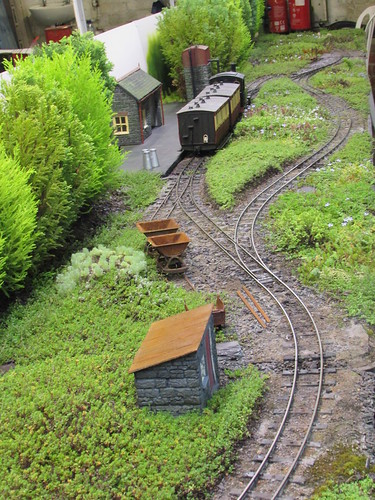
Cowley Yard: William Plant's 7mm scale beautifully weathered, compact layout. The first time I've seen wooden shunting scotches appropriately dropped in the six foot.

Snowy River Rail Road: Daventry MRC showed this very detailed American-outline 0n30 layout ('0' scale using 16.5mm gauge track to represent narrow gauge). Full DCC control.

Ella Road: Alan Maclachlan exhibited this impressive modern-image Traction Maintenance Depot layout in 00 gauge with DCC control.

Marston Jabbett: This double-track mainline with a single-line branch in N gauge (1:148 scale) was shown by the Anker Railway Modelling Society which meets in Chilvers Coton, Nuneaton.

Roofers Lane: South Wigston MRC exhibited their N gauge (1:148 scale) layout.

Wheal Kist: Darren Carter's narrow-gauge granite and china clay quarry layout in 009 (4mm to the foot scale using 9mm gauge 'N' track).
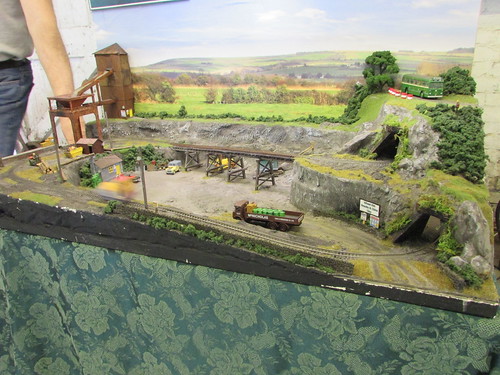
North Rokeby: Heart of England Narrow Gause Modellers displayed their interesting steam-outline layout combining standard gauge (00) and narrow gauge (009) lines.

Norman Colliery: Geoff Brain's atmospheric 0 gauge layout depicting the dereliction common to mines towards the end of their lives.

Ashbridge: A Network South East station and yard layout in 00 gauge, carefully detailed with DCC control and some effective locomotive sounds, displayed by Mark Miller.

Rush Green Colliery: This very nicely-detailed colliery layout in 00 gauge was displayed by Alex Rushton.

Hornby Dublo: Ray Poxon and the Hornby Railway Collectors Association showed a third-rail table-top layout.

Triang: David White's layout featured Triang Railways in 00 gauge, Triang Minic Motorways and Triang Model-land figures and buildings.

: Birmingham Railway Museum Layout This very detailed (if a little careworn) 4mm model of the Museum was displayed as a static exhibit. I found it very evocative, having been an operating volunteer at the Museum for many years.

Further attractions included an elaborate layout for young people using sectional wooden track from the Swedish company Brio (now part of the German Ravensburger group), a working 'Thomas and Friends' layout in G scale and a large Lego Harry Potter display (complete with a Quidditch Match in progress). There was even the opportunity to pay for a short drive on the full-size battery electric locomotive 'Spondon No. 1' along the siding opposite the Goods Shed (the 'Turnback Siding' when some services terminate at Market Bosworth).
Finally, the normal Battlefield Line weekend service operated, hauled by a Class 33 diesel electric locomotive. This provided four trips from Shackerstone to Shenton and return during the day, calling at Market Bosworth in both directions. Overall, the various attractions provided a splendid and most enjoyable event.
Previous posts describing modelling events on the Battlefield Line
The 50th Gala in 2019 included a wonderful layout Gauge 1 layout which I briefly describe in my post Shackerstone Railway Society 50th Anniversary Steam Gala. Previously, I'd been to a couple of model weekends at Shackerstone, both enjoyable but neither on the scale of the 2023 event. In June 2017, working a 'split shift' on 'Cumbria' gave me a chance to study the Model Steam Weekend exhibition. My report is here, with links to pictures. During the May 2012 event, I was driving the DMU and I only managed a 'whistle-stop' tour of the models on display. My post is here, with a link to my pictures.
My pictures of the 2023 event
Battlefield Line, Models Weekend 2023.
I'm normally alert to any railways I may encounter in my travels but the significance of the location for a business meeting at Felin Fawr near Bethesda on Tuesday 22nd August 2023 (described in the post here) had failed to register until my friend said "There's an abandoned railway out the back!". After the meeting here wasn't much time to explore, but I made sure of a few pictures to prompt further study later. This post reports what I found.
I knew that the meeting location was near Penrhyn Quarry, which was once the largest slate quarry in the world. But I didn't know that Felin Fawr was the processing site for slate and the building which had hosted my meeting was formerly a Slab Mill producing sawn slate for building purposes. There are useful Wikipedia articles on the slate industry in Wales, the quarry and Felin Fawr Slate Works.

Railway sidings at Felin Fawr in 2023. The meeting was located in the building on the left.
Slate from Penrhyn was used locally from the 16th century but development of the industry in the 1770s was due to Richard Pennant (see 'Notes on the Pennant family' below). Initially, slate was carried in panniers by horse down the mountain to the docks at Port Penrhyn for onward shipment.
Around 1800 the Penrhyn Railroad was constructed, using oval rails fitted at 2 foot and half an inch centre-to-centre, apparently incorporating the somewhat earlier Llandegai Tramway. Haulage was by horses and the most difficult sections were provided with inclined planes operated as a gravity balance cable railway with two tracks. A cable attached to an ascending empty wagon wound around a drum at the top of the incline and attached to a loaded wagon descending means no external power was required. Control was provided by braking on the drum.
In 1878 the operation was transferred to a new, parallel railway using steam locomotive haulage throughout. The inclined planes were eliminated by deviations in the route, increasing route length but easing the grades. Trackwork was conventional and track gauge (measured in the normal way, between inner edges of rails) became 1 foot 10 3/4 inches. In this form, as the Penrhyn Quarry Railway, the system operated until 1962. In 2012, enthusiasts reinstated the trackwork around Felin Fawr which I'd found on my visit. Various galas and operating days were held between 2012 and 2017 when, sadly, the initiative ceased.
Wikipedia has notes on the railways and various cable railways There's an excellent, detailed history of the Penrhyn Quarry Railway in posts by Roger Farnworth here and here.
I also found three interesting articles and photographs by Graham Stephen about the Felin Fawr site. The first clarifies the layout of the Slate Mill. The second shows what remained around 2012 of a waterwheel which powered the mill. The third shows the locomotive shed during the sadly short-lived attempt to restore the railway as a preserved line. The waterwheel was of the suspended pattern, built by De Winton of Caernarfon (who also supplied some of the early steam locomotives for the Penrhyn Quarry Railway). An article by Steve Mills for the Gloucestershire Society for Industrial Archaeology here outlines the advantages of suspension water wheels and rim gearing.

Former Penrhyn Quarry Railway 'Blanche' restored (and heavily modified) at Festiniog Railway (Photo: A.M.Hurrell, CC BY-SA 3.0)
Notes on the Pennant family
Thomas Pennant (died 1522) was the Abbot of Basingwerk Abbey, Holywell. His grandson Gifford Pennant became a successful sugar planter in Jamaica. On his death the profitable sugar plantations, worked by slave labour, passed to Gifford's son Edward Pennant (1672-1736) who further developed the holdings whilst rising in the Jamaican establishment. On Edward's death, the estates passed to his sons John, Samuel and Henry (with care provision for a fourth son). Despite the family wealth, life in Jamaica could be challenging and the three brothers returned to England, leaving the plantations to be administered by agents and entered English society. John Pennant became a successful Liverpool merchant. Liverpool was, of course, the port of entry for Jamaican sugar. Samuel and Henry died without heirs, leaving their estates to John. Through a partnership in the salt trade with Colonel Warburton John became interested in the medieval estate of Penrhyn which was part owned by Colonel Warburton's wife. John, with his second son Richard Pennant (1739-1808), started buying up the remainder of the Penrhyn estate. Richard Pennant's political career started in 1761 when he became the Member of Parliament for Petersfield but, when a vacancy arose in Liverpool in 1767 he was returned unopposed. He married Colonel Warburton's daughter Anne Susanna in 1767.
Upon the death of John Pennant in 1781, the Penrhyn estate effectively became reunited, Richard inheriting part from his father and the balance through his wife. He also became absentee owner of the sugar plantations in Jamaica. In the election of 1780 he lost his seat in the House of Commons and was subsequently created !st Baron Penrhyn in 1783. Because this new creation was an Irish peerage, he was not allowed to sit in the House of Lords but able to stand for the House of Commons, allowing him to regain the Liverpool seat in 1784. Richard spoke in the House of Commons about trade and Liverpool concerns and remained opposed to the abolition of slavery. He was an enthusiastic supporter of projects to develop his Welsh estates and created the massive Penrhyn quarry. Previously, individuals would pay the landowner for the right to extract slate which was brought out by packhorses. Richard created an industry where the landowner took control of extraction and transport, paying employees a wage. He expanded the market for slate by building Port Penrhyn, Bangor, connected to the quarry by horse-drawn railroad.
On Richard's death in 1808, since he had no children, his Baronetcy lapsed and the ownership of the estates passed to his second cousin provided he added 'Pennant' to his name, becoming George Hay Dawkins-Pennant (1764-1840). George married for the first time in 1807 and had two daughters. He continued to develop the Penrhyn estate and received government compensation for the freeing of his slaves when slavery was abolished. In 1833, his elder daughter and co-heiress Juliana Isabella Mary Dawkins-Pennant married a Grenadier Guards officer, Edward Gordon Douglas (1800-1886).
By Royal licence, Edward Gordon Douglas changed his name to Edward Douglas-Pennant, allowing him to inherit the Penrhyn estate from his wife's father, George. In 1866 Edward Douglas-Pennant was raised to the peerage in a second creation of the title Baron Penrhyn, this time as an 'English' peerage. Developments at Penrhyn quarry and the Penrhyn estates continued. By his first wife, Juliana Isabella Mary Dawkins-Pennant, he had two sons and three daughters. During the 1868 general election, 80 quarry workers declined to vote for the Baron's son George who, at that time, was pursuing a political career and were sacked. After the death of his first wife, the 1st Baron re-married and had further children
The 1st Baron died in 1886 and his elder son George Douglas-Pennant (1836-1907) became the 2nd Baron, thereafter concentrating on the running of the various businesses. Penrhyn quarry workers went on strike in 1896, leading to closure of the quarry for 11 months. The 2nd Baron was unrelenting and the strikers resumed work on the same terms. A second strike in 1900 lasted for three years, earning 'The Great Strike of Penrhyn' a special place in the history of the Trades Union Congress. The 2nd Baron was clearly a complex man of strong convictions, hinted at in the biography in the Dictionary of National Biography. After reading about the turbulence of the nineteenth century, I decided not to pursue the Pennant history into the 20th century.
Notes on Penrhyn Castle
Penrhyn Castle was clearly important to the Pennant family and although externally the castle gives the appearance of being ancient, it is not. Between 1822 and 1837, the architect Thomas Hopper (1776-1856) created the imposing appearance. The castle is regarded as his finest work and listed Grade 1. As a National Trust site, it is open to the public and the former Stables houses a railway museum including Penrhyn Quarry Railway artefacts. There's an article about the railway museum on Wikipedia here and there's an entertaining record of the railway museum activities written by one of the former museum volunteers, Keith Jaggers, here. There's lots more about the Jagger's family history and Keith's interest in railways here. Over 2,000 documents from Penrhyn Castle have been archived at Bangor University, providing a valuable insight into transatlantic slave trade and plantation slavery. Dr. Marian Gwyn has researched these areas and there's an interesting article by her outlining the connection between Penrhyn Castle and slavery here.
List of referenced posts on other websites
Slate Industry in Wales (Wikipedia).
Penrhyn Quarry (Wikipedia).
Felin Fawr Slate Works (Wikipedia).
Penrhyn Quarry Railway (Wikipedia).
Cable railway (Wikipedia).
Penrhyn Quarry Roger Farnworth: Penrhyn Quarry Railway (Part 1).
Penrhyn Quarry Roger Farnworth: Penrhyn Quarry Railway (Part 2).
Suspension water wheels and rim gearing
FELIN FAWR WORKS Graham Stephen (GeoTopoi).
FELIN FAWR WATERWHEEL Graham Stephen (GeoTopoi).
FELIN FAWR LOCOMOTIVE SHED Graham Stephen (GeoTopoi).
Richard Pennant, 1st Baron Penrhyn (Wikipedia).
George Hay Dawkins-Pennant (Wikipedia).
Edward Douglas-Pennant, 1st Baron Penrhyn (Wikipedia).
George Douglas-Pennant, 2nd Baron Penrhyn (Wikipedia).
The great Penrhyn quarry strike (TUC).
Dictionary of National Biography, 1912 supplement.
Penrhyn Castle (Wikipedia).
Thomas Hopper (architect of Penrhyn Castle) (Wikipedia).
Penrhyn Castle Railway Museum (Wikipedia).
Penrhyn Castle Railway Museum: Vol 2 (Keith Jaggers).
Keith and Elizabeth Jaggers Family Heritage.
Penrhyn Castle and Slavery (Dr. Marian Gwyn).
My pictures
My pictures at Felin Fawr Cyf (showing the reconstructed trackwork) are here.
I'd agreed to attend a business meeting near Bangor on Tuesday 22nd August, 2023. The people we're working with on this project were travelling from the south-west on Monday to be at the meeting and they suggested that we might travel together by car and that they would collect me around 1 p.m. This allowed me to work in the office in the morning, before they arrived at lunchtime.
The weather was good, so there was time for a brief tour of the garden and the Hall before we set-off together. It was agreed that we'd take the 'pretty route', using the A5 through Llangollen. Since this would take us near the commercial woodland at Ty Gwyn, it was further agreed that we'd make a short detour to Ty Gwyn as neither of my friends had previously visited the plantation.
After a pleasant journey, the weather remained mild on arrival at Ty Gwyn and we were able to explore the forest roads on foot.

Alex and Steve at Ty Gwyn 2023
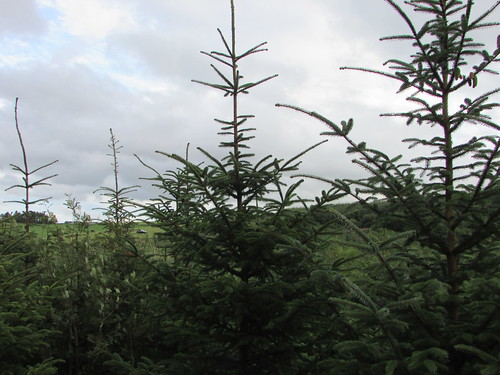
Ty Gwyn 2023: Progress achieved by the sitka spruce which was replanted in 2016.
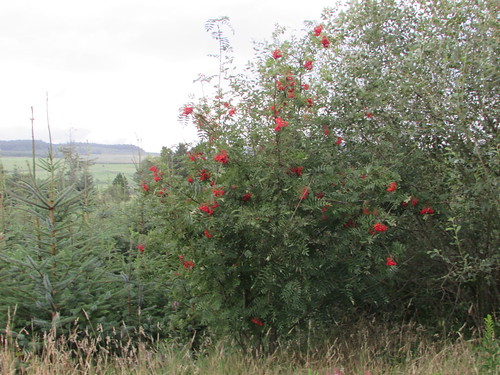
Splendid Rowan berries: Ty Gwyn 2023
Leaving Ty Gwyn, we headed on through the spectacular scenery around Snowdonia as the weather rapidly deteriorated. Having negotiated heavy rain, conditions improved as we approached Bangor at dusk. Overnight accommodation had been arranged at The Management Centre operated by Bangor University. The main university campus at Bangor is at the summit of a hill overlooking the town and the Menai Strait. The Management Centre is a Residential Training, Conference and Events Venue housed in three buildings built in 1910 on the slope below the main campus. After restoration and refurbishment, these three buildings were re-opened with their present role in 2010. My pleasantly-situated room in one residential block gave a view of the main Management Centre building to the left, faced a similar residential block and revealed the Menai Strait looking to the right.

Main Management Centre building, Bangor

View of the Menai Strait from The Management Centre, Bangor
We'd arrived early enough to take dinner in the '1884' restaurant at The Management Centre (1884 was the founding date of Bangor University). Informed that fish had run out (my usual choice), I opted for vegetarian tagliatelle which was very good. After the enjoyable meal with my friends, I was happy to retire to my well-appointed bedroom for a good night's sleep. On Tuesday morning, we took the buffet breakfast at the '1884' before setting off for our meeting.

Bedroom at The Management Centre, Bangor
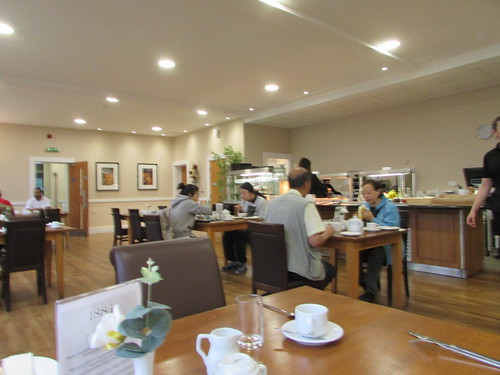
Breakfast at '1884' Restaurant, The Management Centre, Bangor
Since our meeting was scheduled to last all day, we made a brief stop on the way at the large Marks and Spencer's supermarket to select sandwiches, snacks and drinks to sustain us. The meeting was near Bethesda at Felin Fawr Cyf. Here, a series of early industrial buildings have been converted into 'Units' for small business use. Concentrating on the business of the meeting, my antenna failed to alert me to the significance of the location until Steve said "There's an abandoned railway out the back!". When the meeting finished, Steve was hoping to drive back to South Wales, dropping me off on the way so there wasn't much time to explore, but I made sure of a few pictures to prompt further study later. I was puzzled that the truncated trackwork, with a gauge of around two feet, included some modern sleepers, indicating fairly recent (say within 10 years) maintenance. Well, that was a puzzle for the future. I was returned home safely by car after an interesting couple of days and eventually added a post about the Penrhyn Quarry Railway here.

Railway sidings at Felin Fawr
Related posts on other websites
The Management Centre, Bangor.
Related posts on this website
My posts on Brewood Hall are here.
My posts on Ty Gwyn are here.
My pictures
My pictures of Brewood Hall are here.
My pictures of Ty Gwyn are here.
My pictures of The Management Centre are here.
My pictures at Felin Fawr Cyf (showing the reconstructed trackwork) are here.
[Link to Penrhyn Quarry Railway post added 31-Oct-2023]
On Monday 12th June 2023, I visited the former Nant Helen Opencast and associated Onllwyn Washery site (extending to 550 hectares) which is to become the Global Centre of Rail Excellence (GCRE) in South Wales to attend their 'Open Day'. I travelled by rail to Newport the previous day with an overnight stay in Newport (described here). before the 'Open Day' visit.
A liitle background
The geology of Wales gave the country massive deposits of coal and other minerals. Initially, early tramroads were used to assist extraction but the growth of steam power (in manufacturing, railways and steamships) increased demand and led to a series of railways being created. The Dulais Valley had a number of mines, giving rise to various local iron and copper works.
Over time, underground mining gave way to opencast mining. Excavators first remove topsoil which is taken away by large dump trucks (called 'Haulers') and stored in soil mounds to be reused when mining is complete. Excavators then remove the unwanted material ('overburden') to access the coal-bearing layers beneath, resulting in a large pit or void, equipped with a network of roads allowing the coal extracted by excavators to be hauled away. Remediation of areas once extraction ceases can start in some areas even as opencast mining continues in others.
Until 2022, coal from Nant Helen was loaded onto rail wagons at Onllwyn Washery and carried away using the former Neath and Brecon Railway. The refusal by the Coal Authority (a non-departmental public body sponsored by the Department for Energy Security and Net Zero) to issue a license for continued extraction forced closure of the mine and Washery and the railway was mothballed.
The Welsh Government, Powys County Council and Neath Port Talbot County Council developed an ambitious scheme to convert the Nant Helen site into a world-class test site for railway rolling stock and advanced railway infrastructure construction techniques called Global Centre for Rail Excellence (GCRE). GCRE will compete with existing facilities at Wildenrath, Velim and Old Dalby (Wikipedia)
The Open Day
Invitees to the open day were representatives from organisations who'd been involved in Innovate UK Phase 1 Bids at the site and were interested in bidding for further support on twelve projects during Phase 2 of this project. The meeting point was Onllwyn Welfare Hall (formerly Onllwyn Miners' Welfare Hall). After brief introductions given by GCRE staff, participants were divided into a number of parties to be escorted on a tour of the site using a fleet of Land Rovers. The site of GCRE is currently a building site where remediation work is being carried out using heavy plant, so the Construction (Design and Management) Regulations 2015, usually referred to as 'CDM Regs', apply requiring invitees to use full Personal Protective Equipment (PPE) during the tour.

GCRE: Onllwyn Welfare Hall, GCRE 'Open Day'
The Land Rovers were lined up in the car park outside the Welfare Hall and, once loaded, a short drive on public roads took us to the road overbridge where the currently-disused single-line railway from Neath enters the Nant Helen site near Onllwyn Washery.

GCRE: View from bridge over railway on Onllwyn Road, looking towards former Washery. Note trap points, operated from single-lever ground frame incorporating a keylock

GCRE: View from bridge over railway on Onllwyn Road, looking towards Neath. In the distance, note the level crossing on an internal site road formerly used by mining vehicles.
We then continued on a surfaced internal site road towards the offices of the former opencast complex.

GCRE: Land Rover Site Tour approaching offices/car park through land restored L: 1995-2000 R: 1980-1990

GCRE: Land Rover Site Tour passing the Offices/Car Park
We continued past the offices to the northern boundary of the site where we stopped to see the result of remediation work, including tree planting, carried out between 1993 and 1998.

GCRE: Land Rover Site Tour paused to show the land towards the north of the site restored between 1993 and 1998.
Looking north, there were impressive view towards the Brecon Beacons with Abercrave village in the foreground (served by the A4221 road hidden in the trees).
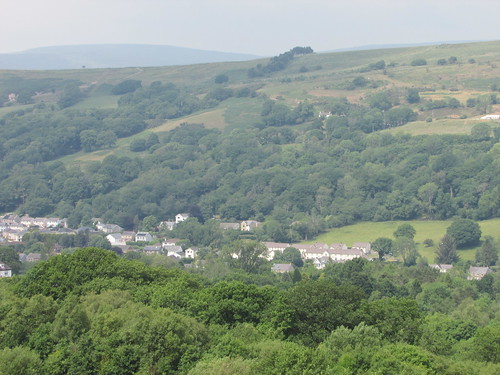
GCRE: Land Rover Site Tour showing Abercrave to the north of the site.
The Land Rovers returned to the office complex and turned west, past rows of parked heavy plant left and right and what I assumed were the vehicle maintenance workshops. From here, we continued on what had been named the Haul Road - a feature of mining sites where massive vehicles bring back the extracted material from the working face to a central point for processing or distribution. Some heavy plant was in use but many vehicles appeared to be in store. Presumably some of the plant previously used in the extraction of coal has been re-purposed for the ongoing remediation work.

GCRE: Land Rover Site Tour showing tracked excavators in store. They appear to be Komatsu PC 2000. CAT 'Dozers' are also parked
Our Land Rovers started to prove their worth as we entered a grey 'moonscape' where the surface, frequently wide enough for a motorway, had been rolled but not surfaced.
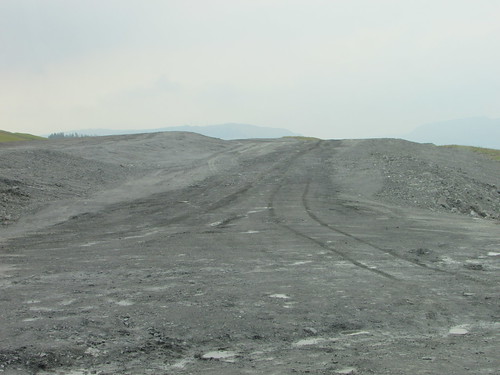
GCRE: Land Rover Site Tour on the Haul Road

GCRE: Land Rover Site Tour showing a 20-ton tracked excavator (JCB 220X LC) operated by Walters with a number of Volvo A30G Articulated Haulers parked
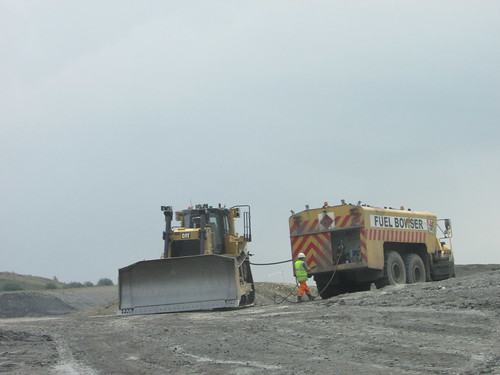
GCRE: Land Rover Site Tour on the Haul Road showing a CAT 'Medium Dozer' being refuelled from a Fuel Bowser

GCRE: Land Rover Site Tour passes a Volvo A30G Articulated Hauler ('Dump Truck') which can carry a 29 tonne net load
I was fascinated as we approached an unfamiliar-looking tracked machine being loaded onto a trailer. By the time we passed the scene, the machine had been left halfway up the trailer ramp. It appeared to be a drilling rig but, knowing nothing of groundworks, it took a little searching to conclude it was a Eijkelkamp Fraste CRS XL140 DUO multi-purpose sonic rig.

GCRE: Land Rover Site Tour on the Haul Road with plant at work and Drilling Rig about to be loaded onto low loader hauled by tractor
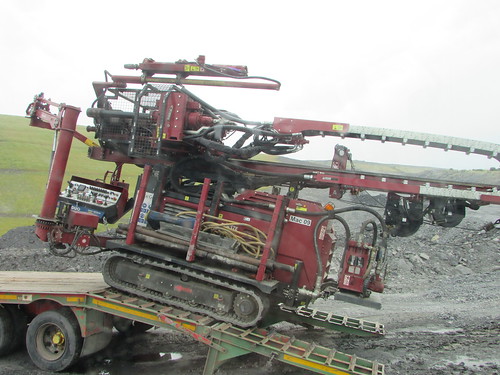
Eijkelkamp Fraste drilling rig: It appears to be a CRS XL140 DUO multi-purpose sonic rig (GCRE)
Mining operations had left a large Void and the tour paused to allow the appearance, somehat softened by remediation work and fringed by spruce trees, to be viewed.
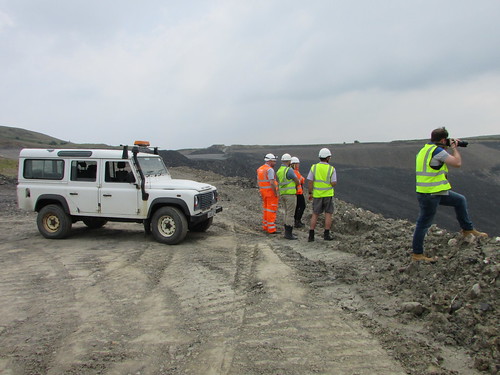
GCRE: Land Rover Site Tour paused to view the Void

GCRE: Land Rover Site Tour at The Void
At the highest point on the site, we passed a battered-looking self-supporting telescopic antenna which had been used for site communication using hand portables or private mobile radios.

GCRE: Land Rover Site Tour passes a rather battered transmission tower which supported site communications
The Land Rovers then returned us to the Welfare Hall for welcome refreshments.

GCRE: Onllwyn Welfare Hall, GCRE 'Open Day'
In the afternoon, we had a walking tour, proceeding on foot to the railway bridge on Onllwyn Road. After some discussion regarding the planned work to renew the rusting structure and adjust the railway track level, we took the internal site road to the level crossing on the Neath site of the bridge. It looked as if the level crossing and associated site roads had been provided to allow heavy road traffic from the mine to reach the Washery without crossing the rather fragile-looking road bridge.
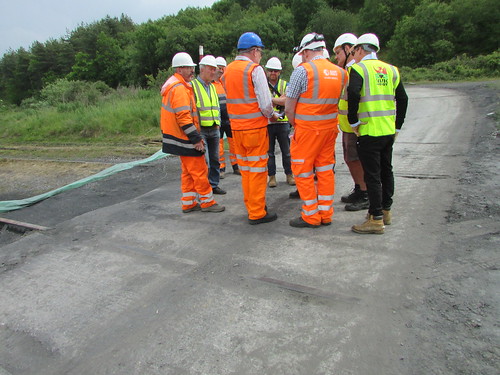
GCRE: Washery-Depot Area Walking Tour, GCRE Open Day, showing party joining the branch line at the level crossing
The tour continued along the railway track towards the Washery, passing under the Onllwyn Road bridge.

GCRE: Washery-Depot Area Walking Tour, GCRE Open Day, showing Onllwyn Road bridge with stone-built pediments.
We passed the original trap points, operated from a key-locked single-lever ground frame, which controlled movements from the Washery area onto the single line to Neath. Two original turnouts remain, as the single line fans out, but further on all permanent way has been lifted with a few panels of track neatly piled.

GCRE: Washery-Depot Area Walking Tour, GCRE Open Day, showing two turnouts and stop block. Note spare track panels in background.
Beyond here, the original sidings have been lifted and earthworks have been carried out, leaving a solitary abandoned CCTV camera (fitted in what appears to be a Dennard pan and tilt housing with windscreen wiper).

GCRE: Washery-Depot Area Walking Tour, GCRE Open Day, showing abandoned CCTV camera. Note tripod for surveying equipment in background.
Although the walking had tired me, it was disappointing that we didn't go further into the Washery area but instead cut through a car park near the security building and site entrance from Onllwyn Road to regain the public road and return to the Welfare Hall.
An unusual and absorbing visit.
Introduction to other Test Centres on other websites
Wegberg-Wildenrath Test and Validation Centre (Wikipedia)
Velim test centre (Wikipedia)
VUZ TEST CENTRE VELIM
Old Dalby Test Track (Wikipedia)
The Old Dalby Test Track
Related articles on other websites
History of Onllwyn Collieries (Welsh Coal Mines)
Global Centre for Rail Excellence (Wikipedia)
Eijkelkamp Fraste CRS XL140 DUO
Coal Authority (Wikipedia)
Related posts on this website
By Train to Newport (Getting to Wales for the Open Day)
My pictures
GCRE.




































































